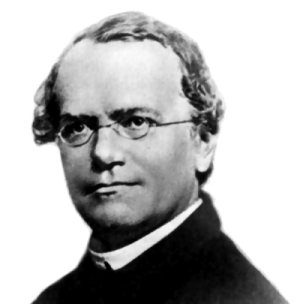
Gregor Mendel (1822 – 1884)
On February 8, 1865, German-speaking Silesian scientist and Augustinian friar Gregor Mendel publishes his “Versuche über Pflanzenhybride” (Experiments on Plant Hybridization) in which he describes his experiments with peas, which later became the foundation of the so-called Mendelian inheritance of genetics.
“It is willingly granted that by cultivation the origination of new varieties is favored, and that by man’s labor many varieties are acquired which, under natural conditions, would be lost; but nothing justifies the assumption that the tendency to formation of varieties is so extraordinarily increased that the species speedily lose all stability, and their offspring diverge into an endless series of extremely variable forms. Were the change in the conditions the sole cause of variability we might expect that those cultivated plants which are grown for centuries under almost identical conditions would again attain constancy.”
– Gregor Mendel, Experiments with Hybrids of Other Species of Plants (1865)
Gregor Mendel Background
Mendel grew up in a farmer’s family and cultivated bees from early ages. From 1840 to 1843, he studied practical and theoretical philosophy and physics at the Philosophical Institute of the University of Olomouc, taking another year off because of illness. He became a friar in part because it enabled him to obtain an education without having to pay for it himself. As the son of a struggling farmer, the monastic life, in his words, spared him the “perpetual anxiety about a means of livelihood.” He was given the name Gregor when he joined the Augustinian friars. When Mendel entered the Faculty of Philosophy, the Department of Natural History and Agriculture was headed by Johann Karl Nestler who conducted extensive research of hereditary traits of plants and animals, especially sheep. Upon recommendation of his physics teacher Friedrich Franz, Mendel entered the Augustinian St Thomas’s Abbey in Brno and began his training as a priest. Mendel worked as a substitute high school teacher. In 1850, he failed the oral part, the last of three parts, of his exams to become a certified high school teacher. In 1851, he was sent to the University of Vienna so that he could get more formal education. There, he studied physics with Christian Doppler and anatomy with Franz Unger.[4]
Rules of Inheritance
While living at the Abby, Mendel started his first systematic crossing attempts with peas around 1856. He observed their properties and chose the one’s that were easily to differentiate. Mendel managed to grow over 12,000 hybrids and was able to describe his discoveries on the splitting of their characteristics. He settled on studying seven traits that seemed to inherit independently of other traits: seed shape, flower color, seed coat tint, pod shape, unripe pod color, flower location, and plant height. Until 1863, Mendel grew 28,000 plants and established his today well known Rules of Inheritance. His scientific publication followed in 1865, but unfortunately Mendel’s remarkable research results remained almost unknown for several years. Mendel gave lectures about his findings and even sent his publications to several scientists. He started communicating with the Swiss botanist Carl Wilhelm von Nägeli, who unfortunately did not recognize the importance of Mendel’s achievements.
Later Life
After he was elevated as abbot in 1868, his scientific work largely ended, as Mendel became overburdened with administrative responsibilities, especially a dispute with the civil government over its attempt to impose special taxes on religious institutions. Mendel died on 6 January 1884, at the age of 61.
And Rediscovery
The fundamental importance of the study was therefore only recognised in 1900, after the botanists Hugo de Vries, Carl Correns [10] and Erich Tschermak-Seysenegg had independently carried out such experiments and obtained results consistent with Mendel. The extent to which their interpretation was independent of Mendel, however, and whether they even reached a correct understanding within the framework of Mendel’s laws as early as 1900, was later doubted, first by Tschermak as early as 1966 and then also by Hugo de Vries, who gained access to Mendel’s essay shortly before his 1900 publications, which significantly changed the interpretation of his experiments. Though de Vries later lost interest in Mendelism, other biologists started to establish modern genetics as a science. All three of these researchers, each from a different country, published their rediscovery of Mendel’s work within a two-month span in the Spring of 1900. It was finally noticed, how important Mendel’s experiments and his very accurately performed statistical analysis were. It was also noticed how important Mendel’s findings were in order to support Darwin’s Theory of Evolution.[5]
Eric Lander, Mendel’s Laws, excerpt 1 | MIT 7.01SC Fundamentals of Biology, [10]
References and Further Reading:
- [1] Gregor Mendel, Experiments in plant hybridization (1865)
- [2] Biography: Gregor Mendel (1822–1884)
- [3] Mendel and His Theory of Heredity
- [4] Christian Doppler and the Doppler Effect, SciHi Blog
- [5] Charles Darwin’s ‘On the Origin of Species’, SciHi Blog
- [6] Works by or about Gregor Mendel at Internet Archive
- [7] 1913 Catholic Encyclopedia entry, “Mendel, Mendelism”
- [8] Taylor, Monica (July–September 1922). “Abbot Mendel”. Dublin Review. London: W. Spooner.
- [8] Gregor Mendel at Wikidata
- [9] Timeline of Austrian Biologists via DBpedia and Wikidata
- [10] Eric Lander, Mendel’s Laws, excerpt 1 | MIT 7.01SC Fundamentals of Biology, MIT OpenCourseWare @ youtube
- [11] Carl Correns and the Principles of Heredity, SciHi Blog





